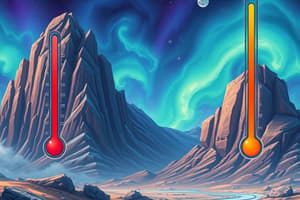Podcast
Questions and Answers
A scientist measures the temperature of a substance to be 300 K. What is this temperature in degrees Celsius?
A scientist measures the temperature of a substance to be 300 K. What is this temperature in degrees Celsius?
- 523.15°C
- 298.15°C
- 26.85°C (correct)
- 573.15°C
If a metal rod is heated at one end, which heat transfer mechanism causes the other end to become hot?
If a metal rod is heated at one end, which heat transfer mechanism causes the other end to become hot?
- Advection, carrying heat via fluid movement.
- Conduction, through particle to particle interaction. (correct)
- Radiation, emitting electromagnetic waves.
- Convection, due to the movement of air around the rod.
A sample of gas is heated in a closed container. According to the principles of thermal energy and particle motion, what happens to the gas particles?
A sample of gas is heated in a closed container. According to the principles of thermal energy and particle motion, what happens to the gas particles?
- They move faster, increasing the pressure on the container walls. (correct)
- They slow down, decreasing the pressure on the container walls.
- They solidify, reducing overall volume.
- They remain at the same speed.
During what process do particles move faster and spread out more?
During what process do particles move faster and spread out more?
What is the equivalent of 68°F in degrees Celsius?
What is the equivalent of 68°F in degrees Celsius?
In which state of matter do particles possess the most kinetic energy?
In which state of matter do particles possess the most kinetic energy?
Convert 30°C to Fahrenheit.
Convert 30°C to Fahrenheit.
How does thermal energy manifest in solids?
How does thermal energy manifest in solids?
Flashcards
Celsius to Fahrenheit
Celsius to Fahrenheit
Formula: F = (9/5 × C) + 32. Used to convert Celsius to Fahrenheit.
Fahrenheit to Celsius
Fahrenheit to Celsius
Formula: C = 5/9 × (F - 32). Used to convert Fahrenheit to Celsius.
Celsius to Kelvin
Celsius to Kelvin
Formula: K = C + 273.15. Used to convert Celsius to Kelvin.
Kelvin to Celsius
Kelvin to Celsius
Signup and view all the flashcards
Fahrenheit to Kelvin
Fahrenheit to Kelvin
Signup and view all the flashcards
Thermal Energy
Thermal Energy
Signup and view all the flashcards
Particles in Solids
Particles in Solids
Signup and view all the flashcards
Conduction
Conduction
Signup and view all the flashcards
Study Notes
Temperature Conversions
-
Temperature is commonly measured in Celsius (°C), Fahrenheit (°F), and Kelvin (K).
-
Celsius to Fahrenheit: 𝐹 = (9/5 × 𝐶) + 32.
- Example: 25°C converts to 77°F.
-
Fahrenheit to Celsius: 𝐶 = 5/9 × (𝐹 − 32).
- Example: 77°F converts to 25°C.
-
Celsius to Kelvin: 𝐾 = 𝐶 + 273.15.
- Example: 25°C converts to 298.15 K.
-
Kelvin to Celsius: 𝐶 = 𝐾 − 273.15.
- Example: 298.15 K converts to 25°C.
-
Fahrenheit to Kelvin: 𝐾 = 5/9 × (𝐹 − 32) + 273.15.
Heating and Thermal Energy in Terms of Particles
-
Thermal energy is the energy an object possesses due to the motion of its particles.
-
Particles in Solids:
- Particles are tightly packed and vibrate in place.
- Energy is mainly in the form of vibration.
-
Particles in Liquids:
- Particles are more spread out and move more freely than in solids.
- Energy exists in vibration and movement forms.
-
Particles in Gases:
- Particles are very spread out and move rapidly.
- Molecules have the most kinetic energy due to constant motion.
-
Adding heat to a substance causes particles to move faster and spread out, leading to expansion.
-
Cooling a substance causes particles to slow down and move closer, leading to contraction.
Energy Transfer and Heating Mechanics
-
Energy transfer occurs when heat flows from one place to another.
-
The main mechanisms of heat transfer include conduction, convection, and radiation.
-
Conduction:
- Energy transfer occurs through direct contact.
- Happens in solids and liquids.
- Faster-vibrating particles transfer energy to neighboring cooler particles.
- Example: A metal spoon heats up in hot water.
-
Convection:
- Energy transfer occurs through fluid motion.
- Happens in liquids and gases.
- Warm fluid rises, and cooler fluid sinks, creating a current.
- Example: Warm water rises and cooler water sinks in a boiling pot.
-
Radiation:
- Heat transfers through electromagnetic waves.
- Can happen through a vacuum.
- Example: The Sun heats the Earth.
Studying That Suits You
Use AI to generate personalized quizzes and flashcards to suit your learning preferences.



